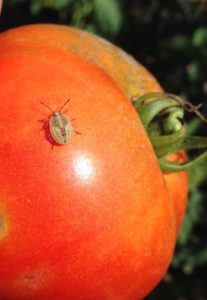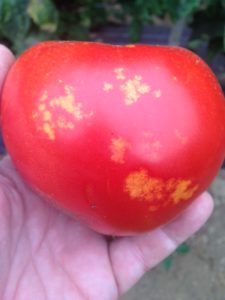Sweet Corn
Fall armyworm (FAW) is increasing in coastal areas, and has been detected at several interior sites as far north as Ocean County. Some infestations in whorl corn are in excess of 20%. It is very possible that economic infestations are present in much of southern New Jersey now. Growers are advised to check whorl and seedling stage corn plantings weekly for signs of FAW. Consider treating if infestation rates exceed 10%. This pest is capable of significant injury to sweet corn plants, resulting in severe stunting and failure to produce viable ears.
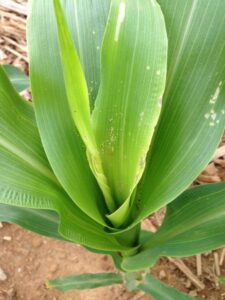
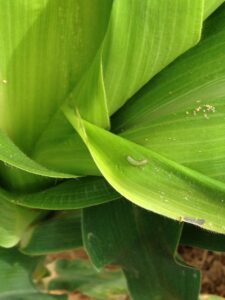 Newly hatched FAW larvae cause holes and scratches on leaves that are similar to European corn borer (ECB) feeding, except that they tend to be more concentrated and always lead down into the whorl (see photos at left). As the larvae grow, the feeding becomes more destructive, with large ragged holes and obvious droppings deposited in the whorl (see photo at right).
Newly hatched FAW larvae cause holes and scratches on leaves that are similar to European corn borer (ECB) feeding, except that they tend to be more concentrated and always lead down into the whorl (see photos at left). As the larvae grow, the feeding becomes more destructive, with large ragged holes and obvious droppings deposited in the whorl (see photo at right). 
We will provide updates on new FAW appearances and severity as reports come in. FAW are resistant to synthetic pyrethroids. Effective sprays should include IRAC grp. 5 (spinosyns) or IRAC grp. 28 (diamides). The carbamate (IRAC grp. 1A) Lannate is also still effective. Sufficient water should be used in the applications to allow the solution to penetrate the layer of droppings that may have formed above the caterpillar.
European corn borer (ECB) moth activity remains extremely low in areas where blacklight traps are operating in the northern and central counties. Many plantings exhibiting no ECB injury at all. We will report on ECB activity should numbers rebound to potentially damaging levels during the second flight. In recent years, this later flight has not required targeted control in sweet corn.
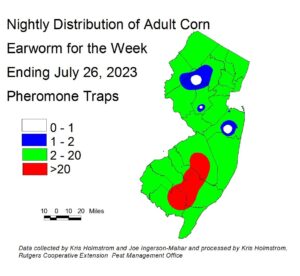 Corn earworm (CEW) moths captures from northern and central blacklight traps remain extremely low, with continued higher catches in the Holmdel region of Monmouth County. Pheromone trap information is available from all northern and central sites, with input from southern New Jersey. We will use a combination of pheromone and blacklight trap types to derive silk spray schedules by region. The numbers from reporting pheromone traps are relatively stable, with recent increases through the heart of southern NJ from Burlington County south through Cumberland County (see CEW pheromone map at right). Silking corn is at significant risk of CEW infestation at this time. Green areas on the map correspond to a 4-5 day schedule, while red corresponds to a 3-day spray schedule. Be sure to access information from this publication in the upcoming weeks to determine how frequently you should treat silking sweet corn to protect it from CEW infestation.
Corn earworm (CEW) moths captures from northern and central blacklight traps remain extremely low, with continued higher catches in the Holmdel region of Monmouth County. Pheromone trap information is available from all northern and central sites, with input from southern New Jersey. We will use a combination of pheromone and blacklight trap types to derive silk spray schedules by region. The numbers from reporting pheromone traps are relatively stable, with recent increases through the heart of southern NJ from Burlington County south through Cumberland County (see CEW pheromone map at right). Silking corn is at significant risk of CEW infestation at this time. Green areas on the map correspond to a 4-5 day schedule, while red corresponds to a 3-day spray schedule. Be sure to access information from this publication in the upcoming weeks to determine how frequently you should treat silking sweet corn to protect it from CEW infestation.
The highest nightly blacklight trap catches of CEW (north and central counties) for the week ending 7/26/23 are as follows:
| Dayton 1 | Milltown 1 |
| Denville 1 | Morristown 1 |
| Farmingdale 1 | New Egypt 1 |
| Hillsborough 1 | Port Murray 1 |
| Matawan 1 | Sergeantsville 1 |
The highest nightly pheromone trap catches of CEW for the week ending 7/26/23 are as follows:
| Tabernacle 35 | Snyder Farm (Hunterdon) 5 | Dayton 3 |
| Elm 28 | Georgetown 4 | Green Creek 3 |
| East Vineland 18 | Allamuchy 3 | Pennington 3 |
| South Branch 6 | Califon 3 | Springdale 2 |
Silking Spray Schedules*:
South – 3-4 days
Central – 4-5 days
North – 5 days
*These recommendations are based on regional catches. Adhere to tighter spray schedules if indicated by local trap catches. Synthetic pyrethroids alone should NOT be used for corn earworm (CEW) protection on silking corn, or for fall armyworm (FAW) management at any stage. Control with these materials is very inconsistent.
Sweet Corn Maps
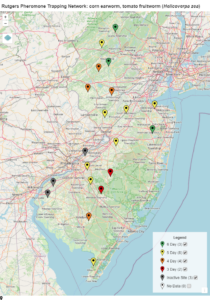 It is expected that in the 2024 growing season, we will transition visual displays of CEW activity from our current map format to a more interactive one on the AgPest Monitor platform. At present, Joseph LaForest of the Southern IPM Center is accepting NJ Vegetable IPM Program pest data on a weekly basis and using it to create maps like the one here for 7/26/23 (at left). In the future, we anticipate adding a link to live maps on AgPest Monitor that will contain reporting sites for corn earworm pheromone traps. Sites are color coded, indicating the silk spray schedule associated with local moth populations. Clicking on these sites will allow users to see the progression of activity through the current season, as well as graphs of recent seasons’ catches. The image here is not “live”, and is simply an example of how this product will look.
It is expected that in the 2024 growing season, we will transition visual displays of CEW activity from our current map format to a more interactive one on the AgPest Monitor platform. At present, Joseph LaForest of the Southern IPM Center is accepting NJ Vegetable IPM Program pest data on a weekly basis and using it to create maps like the one here for 7/26/23 (at left). In the future, we anticipate adding a link to live maps on AgPest Monitor that will contain reporting sites for corn earworm pheromone traps. Sites are color coded, indicating the silk spray schedule associated with local moth populations. Clicking on these sites will allow users to see the progression of activity through the current season, as well as graphs of recent seasons’ catches. The image here is not “live”, and is simply an example of how this product will look.
Peppers
The Rutgers Vegetable IPM Program has a limited number of pepper weevil (PW) trap kits that can be made available to commercial growers in the counties of: Atlantic, Camden, Cumberland and Salem. These kits include lures, sticky cards and mounting equipment. Growers will deploy and check their own traps. Please, commercial growers only. If interested, contact Joseph Ingerson-Mahar via email: Mahar@sebs.rutgers.edu or phone/text: 856-889-5718.
Tomatoes
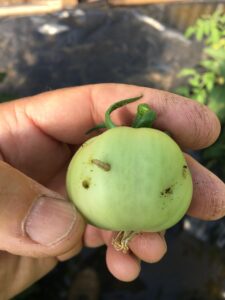
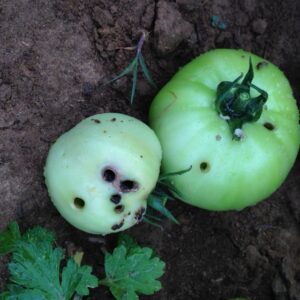 In anticipation of increasing CEW (aka. tomato fruitworm) moth numbers as we move from July into August, it is important to monitor fields for the appearance of injury in tomato plantings. The CEW moth often lays eggs near flower clusters near the upper canopy of plants, resulting in larval damage to green fruit in very visible areas (see photos at left). Larvae typically enter the shoulders of fruit, and may move around, causing injury to multiple fruit. Local pheromone trap catches approaching 20+ CEW per night may warrant preventive sprays for this pest. At minimum, growers should be checking fields for the presence of fruitworm injury. Just as with CEW in sweet corn, effective materials in tomatoes include IRAC 5 (spinosyns) and IRAC 28 (diamides). See the Tomato Section from the 2022-23 Guide for a complete list.
In anticipation of increasing CEW (aka. tomato fruitworm) moth numbers as we move from July into August, it is important to monitor fields for the appearance of injury in tomato plantings. The CEW moth often lays eggs near flower clusters near the upper canopy of plants, resulting in larval damage to green fruit in very visible areas (see photos at left). Larvae typically enter the shoulders of fruit, and may move around, causing injury to multiple fruit. Local pheromone trap catches approaching 20+ CEW per night may warrant preventive sprays for this pest. At minimum, growers should be checking fields for the presence of fruitworm injury. Just as with CEW in sweet corn, effective materials in tomatoes include IRAC 5 (spinosyns) and IRAC 28 (diamides). See the Tomato Section from the 2022-23 Guide for a complete list.
This is the time of the season when native brown stink bugs become active in tomato fields. These true bugs (see photo of Euschistus sp. nymph below at left), move into irrigated tomato fields as forage in the surrounding environment dries out. Feeding results in “cloudy spot” (see photo at right below). Increases in stink bug injury are often found by crews picking the fruit. Growers should consider 1-2 insecticide applications to limit fruit injury if this damage is increasing in harvested fruit. If actively scouting fields, insecticides should be considered if stink bug adults, nymphs or new fruit injury is found in 2 or more sample sites in a 10 site sample. Insecticides that are effective on stink bugs include pyrethroids and neonicotinoids (see Tomato Section from the 2022-23 Guide), so care should be taken to avoid contact with foraging bees.
Cucurbit Downy Mildew
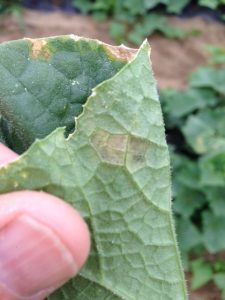
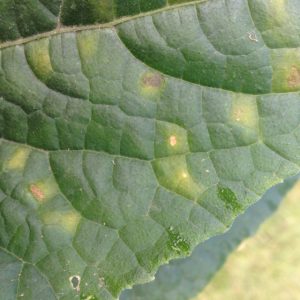 Cucurbit downy mildew is impacting cucumbers in all parts of New Jersey at this time. All cucumber and cantaloupe plantings should be protected. Useful materials for CDM may be found in the Cucumber Section of the 2022/23 Commercial Vegetable Production Recommendations. A sentinel plot is established at Snyder Farm in Hunterdon County, consisting of pumpkin, watermelon, cantaloupe, butternut, acorn, cucumber and kabocha squash will be used to indicate the presence of cucurbit downy mildew in the region, and what crops are affected. As of 7/21/23, CDM was detected on cucumbers in this plot in Hunterdon County. For regional information on this important disease, see the Cucurbit Downy Mildew webpage: http://cdm.ipmpipe.org/. Note that the forecast component of this site is not active this season. However, reports of CDM can still be reported on the site, and may appear on the homepage map down to county level with associated host information. It appears that fewer incidents of CDM are being reported on the site than would be expected. Therefore, it is critical that growers subscribe to the Vegetable Crops edition of the Plant and Pest Advisory in order to receive the most current information on outbreaks from Dr. Andy Wyenandt. Recent heavy rains favor arrival and spread of this disease. All growers should be checking potential host crops at least once a week for signs of infection. Symptoms on the upper leaf surface are yellow lesions bordered by leaf veins (upper right photo), while on the lower surface, dark sporulation may be found (upper left photo).
Cucurbit downy mildew is impacting cucumbers in all parts of New Jersey at this time. All cucumber and cantaloupe plantings should be protected. Useful materials for CDM may be found in the Cucumber Section of the 2022/23 Commercial Vegetable Production Recommendations. A sentinel plot is established at Snyder Farm in Hunterdon County, consisting of pumpkin, watermelon, cantaloupe, butternut, acorn, cucumber and kabocha squash will be used to indicate the presence of cucurbit downy mildew in the region, and what crops are affected. As of 7/21/23, CDM was detected on cucumbers in this plot in Hunterdon County. For regional information on this important disease, see the Cucurbit Downy Mildew webpage: http://cdm.ipmpipe.org/. Note that the forecast component of this site is not active this season. However, reports of CDM can still be reported on the site, and may appear on the homepage map down to county level with associated host information. It appears that fewer incidents of CDM are being reported on the site than would be expected. Therefore, it is critical that growers subscribe to the Vegetable Crops edition of the Plant and Pest Advisory in order to receive the most current information on outbreaks from Dr. Andy Wyenandt. Recent heavy rains favor arrival and spread of this disease. All growers should be checking potential host crops at least once a week for signs of infection. Symptoms on the upper leaf surface are yellow lesions bordered by leaf veins (upper right photo), while on the lower surface, dark sporulation may be found (upper left photo).
Pumpkins and Winter Squash
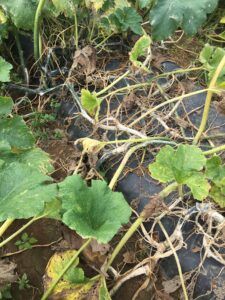
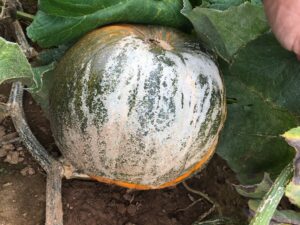 With recent flooding rain events (especially in the northern counties), pumpkin growers should be alert to the possibility of plectosporium blight (see photos at left) impacting plantings prior to the onset of powdery mildew (PM) sprays. The powdery mildew spray schedule is triggered by the appearance of 2 or more PM lesions per 50 mature leaves in a 50 plant sample. Protectant fungicides used in the PM program are useful in limiting plectosporium blight, but if the organism is present in field soil, and wet conditions prevail, it can become a problem prior to initiation of the PM spray schedule. Plectosporium infection results in numerous dry, white lesions on the surface of vines, petioles and fruit. Infected vines become brittle when heavily infected. See Dr. Andy Wyenandt’s post of 7/13 on managing plectosporium blight.
With recent flooding rain events (especially in the northern counties), pumpkin growers should be alert to the possibility of plectosporium blight (see photos at left) impacting plantings prior to the onset of powdery mildew (PM) sprays. The powdery mildew spray schedule is triggered by the appearance of 2 or more PM lesions per 50 mature leaves in a 50 plant sample. Protectant fungicides used in the PM program are useful in limiting plectosporium blight, but if the organism is present in field soil, and wet conditions prevail, it can become a problem prior to initiation of the PM spray schedule. Plectosporium infection results in numerous dry, white lesions on the surface of vines, petioles and fruit. Infected vines become brittle when heavily infected. See Dr. Andy Wyenandt’s post of 7/13 on managing plectosporium blight.
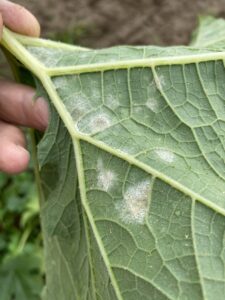 Powdery mildew (PM) thresholds (2 infected leaves/50 leaf sample) have been reached in a few scouted plantings. This has occurred primarily in mixed plantings containing some early maturing gourds. PM typically does not appear until a significant fruit load develops on host plants. Once PM lesions (photo at right) begin to appear, the protectant fungicide program for this disease should be initiated. The program generally includes a combination of broad spectrum protectants and more targeted, locally systemic fungicides. For a complete list of suggested materials, see the Pumpkin and Winter Squash Section of the 2022/23 Commercial Vegetable Production Recommendations.
Powdery mildew (PM) thresholds (2 infected leaves/50 leaf sample) have been reached in a few scouted plantings. This has occurred primarily in mixed plantings containing some early maturing gourds. PM typically does not appear until a significant fruit load develops on host plants. Once PM lesions (photo at right) begin to appear, the protectant fungicide program for this disease should be initiated. The program generally includes a combination of broad spectrum protectants and more targeted, locally systemic fungicides. For a complete list of suggested materials, see the Pumpkin and Winter Squash Section of the 2022/23 Commercial Vegetable Production Recommendations.
